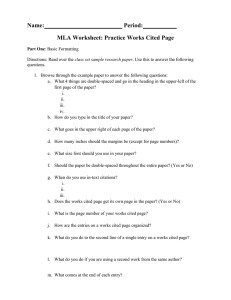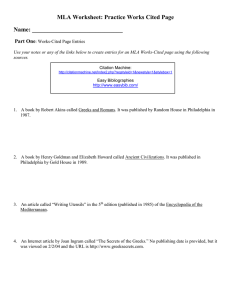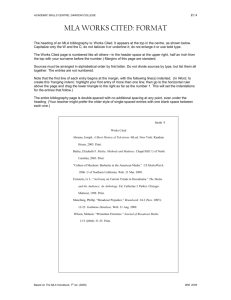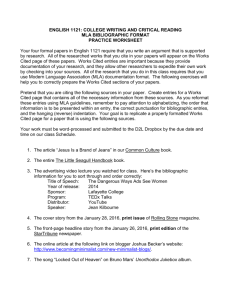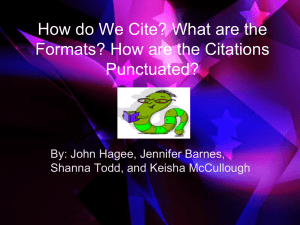Quotes and Phrases
advertisement
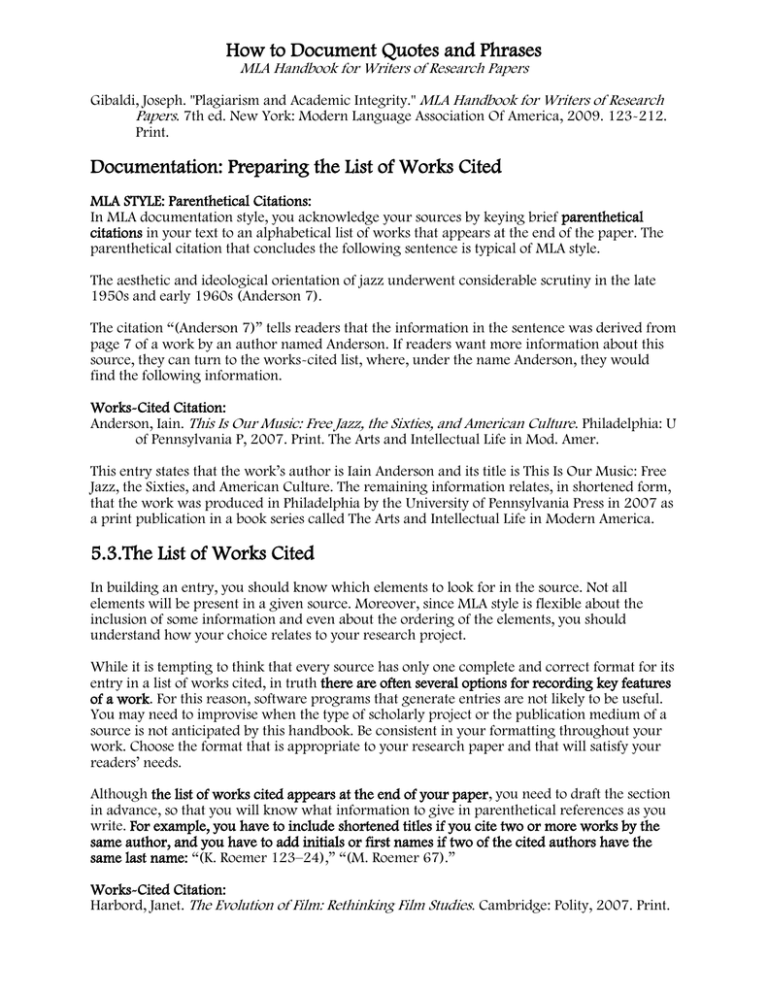
How to Document Quotes and Phrases MLA Handbook for Writers of Research Papers Gibaldi, Joseph. "Plagiarism and Academic Integrity." MLA Handbook for Writers of Research Papers. 7th ed. New York: Modern Language Association Of America, 2009. 123-212. Print. Documentation: Preparing the List of Works Cited MLA STYLE: Parenthetical Citations: In MLA documentation style, you acknowledge your sources by keying brief parenthetical citations in your text to an alphabetical list of works that appears at the end of the paper. The parenthetical citation that concludes the following sentence is typical of MLA style. The aesthetic and ideological orientation of jazz underwent considerable scrutiny in the late 1950s and early 1960s (Anderson 7). The citation “(Anderson 7)” tells readers that the information in the sentence was derived from page 7 of a work by an author named Anderson. If readers want more information about this source, they can turn to the works-cited list, where, under the name Anderson, they would find the following information. Works-Cited Citation: Anderson, Iain. This Is Our Music: Free Jazz, the Sixties, and American Culture. Philadelphia: U of Pennsylvania P, 2007. Print. The Arts and Intellectual Life in Mod. Amer. This entry states that the work’s author is Iain Anderson and its title is This Is Our Music: Free Jazz, the Sixties, and American Culture. The remaining information relates, in shortened form, that the work was produced in Philadelphia by the University of Pennsylvania Press in 2007 as a print publication in a book series called The Arts and Intellectual Life in Modern America. 5.3.The List of Works Cited In building an entry, you should know which elements to look for in the source. Not all elements will be present in a given source. Moreover, since MLA style is flexible about the inclusion of some information and even about the ordering of the elements, you should understand how your choice relates to your research project. While it is tempting to think that every source has only one complete and correct format for its entry in a list of works cited, in truth there are often several options for recording key features of a work. For this reason, software programs that generate entries are not likely to be useful. You may need to improvise when the type of scholarly project or the publication medium of a source is not anticipated by this handbook. Be consistent in your formatting throughout your work. Choose the format that is appropriate to your research paper and that will satisfy your readers’ needs. Although the list of works cited appears at the end of your paper, you need to draft the section in advance, so that you will know what information to give in parenthetical references as you write. For example, you have to include shortened titles if you cite two or more works by the same author, and you have to add initials or first names if two of the cited authors have the same last name: “(K. Roemer 123–24),” “(M. Roemer 67).” Works-Cited Citation: Harbord, Janet. The Evolution of Film: Rethinking Film Studies. Cambridge: Polity, 2007. Print. 5.3.2.Placement of the List of Works Cited The list of works cited appears at the end of the paper. Begin the list on a new page and number each page, continuing the page numbers of the text. For example, if the text of your research paper ends on page 10, the works-cited list begins on page 11. The page number appears in the upper right-hand corner, half an inch from the top and flush with the right margin (see fig. 12). Center the title, Works Cited, an inch from the top of the page. Double-space between the title and the first entry. Begin each entry flush with the left margin; if an entry runs more than one line, indent the subsequent line or lines one-half inch from the left margin. This format is sometimes called hanging indention, and you can set your word processor to create it automatically for a group of paragraphs. Hanging indention makes alphabetical lists easier to use. Double-space the entire list, both between and within entries. Continue the list on as many pages as necessary. 5.3.3.Arrangement of Entries Entries in a works-cited list are arranged in alphabetical order, which helps the reader to find the entry corresponding to a citation in the text. In general, alphabetize entries in the list of works cited by the author’s last name, using the letter-by-letter system. Example: Descartes, René De Sica, Vittorio MacDonald, George McCullers, Carson If two or more entries citing coauthors begin with the same name, alphabetize by the last names of the second authors listed. Scholes, Robert, and Robert Kellogg Scholes, Robert, Carl H. Klaus, and Michael Silverman Scholes, Robert, and Eric S. Rabkin *If the author’s name is unknown, alphabetize by the title, ignoring any initial A Works-Cited Citation: Bakhtin, M. M. (see also Vološinov, V. N.). The Dialogic Imagination: Four Essays. Ed. Michael Holquist. Trans. Caryl Emerson and Holquist. Austin: U of Texas P, 1981. Google Book Search. Web. 3 Dec. 2007. Penelope, Julia (see also Stanley, Julia P.). “John Simon and the ‘Dragons of Eden.’” College English 44.8 (1982): 848-54. JSTOR. Web. 3 Dec. 2007. Stanley, Julia P. (see also Penelope, Julia). “‘Correctness,’ ‘Appropriateness,’ and the Uses of English.” College English 41.3 (1979): 330-35. JSTOR. Web. 3 Dec. 2007. Vološinov, V. N. [M. M. Bakhtin]. Marxism and the Philosophy of Language. Trans. Ladislav Matejka and I. R. Titunik. Cambridge: Harvard UP, 1986. Google Book Search. Web. 3 Dec. 2007. 5.4.Citing Periodical Print Publications Entries for publications in print periodicals consist of several elements in a prescribed sequence. This list shows most of the possible components of an entry for an article in a print periodical and the order in which they are normally arranged: 1.Author’s name (for more than one author, see 5.5.4; for a corporate author, see 5.5.5; for an anonymous work, see 5.5.9) 2.Title of the article (in quotation marks) 3.Name of the periodical (italicized) 4.Series number or name (if relevant; see 5.4.4) 5.Volume number (for a scholarly journal) 6.Issue number (if available, for a scholarly journal) 7.Date of publication (for a scholarly journal, the year; for other periodicals, the day, month, and year, as available) 8.Inclusive page numbers 9.Medium of publication consulted (Print) 10.Supplementary information
